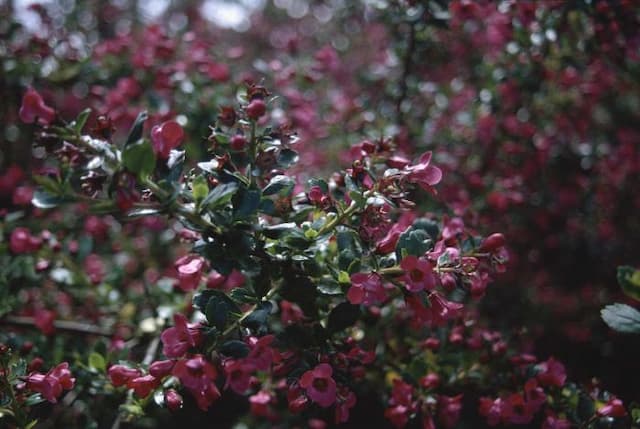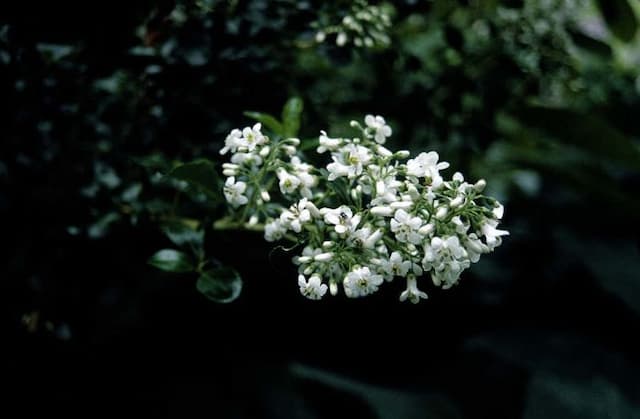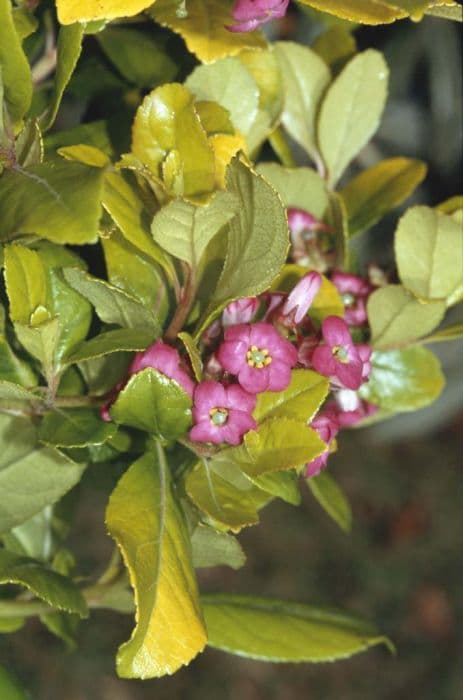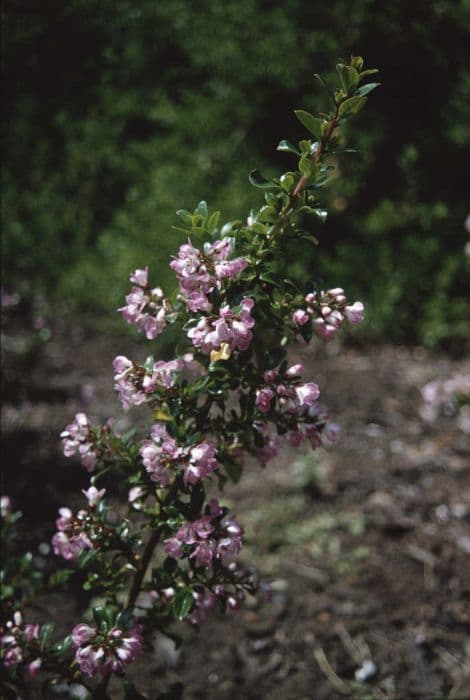Red Dream Escallonia Escallonia punctata 'Red Dream'

ABOUT
Escallonia 'Red Dream' is an evergreen shrub that boasts glossy, deep green leaves. These leaves have a slightly serrated edge, conferring a textured appearance to the shrub's dense foliage. It is during its flowering season that 'Red Dream' truly captivates the eye. The plant is adorned with a profusion of small, vibrant red flowers. These blossoms are tubular in shape, closely grouped together in clusters, creating a striking contrast against the dark green of the leaves. The combination of the year-round lush foliage and the seasonal bright flowers make 'Red Dream' a standout plant in any garden space.
About this plant
 Names
NamesFamily
Escalloniaceae
Synonyms
Red Dream Escallonia
Common names
Escallonia punctata 'Red Dream'.
 Toxicity
ToxicityTo humans
Escallonia 'Red Dream' is not commonly known to be toxic to humans. While no specific information about this cultivar's toxicity is available, Escallonia species, in general, are not listed as toxic plants for human ingestion. If you suspect poisoning from any plant not known to be safe, seek medical attention.
To pets
Escallonia 'Red Dream' is not widely recognized as a toxic plant to pets. General information on the Escallonia genus does not indicate significant toxicity to dogs, cats, or other animals. However, as with any plant not traditionally considered pet food, it's prudent to prevent pets from ingesting this plant. If your pet exhibits unusual symptoms after ingesting part of this plant, consult with a veterinarian.
 Characteristics
CharacteristicsLife cycle
Perennials
Foliage type
Evergreen
Color of leaves
Green
Flower color
Red
Height
2-3 feet (0.6-0.9 meters)
Spread
3-4 feet (0.9-1.2 meters)
Plant type
Shrub
Hardiness zones
7
Native area
South America
Benefits
 General Benefits
General Benefits- Attractive foliage: Escallonia 'Red Dream' offers glossy, evergreen leaves which provide year-round interest.
- Colorful flowers: It produces clusters of striking, red flowers that can brighten up any garden space.
- Wildlife attraction: The flowers attract bees, butterflies, and other beneficial insects, supporting local biodiversity.
- Low maintenance: It's known for being easy to care for, requiring minimal pruning and upkeep.
- Drought tolerance: Once established, it has a good tolerance to drought, making it suitable for drier climates.
- Wind resistance: The plant is fairly wind-resistant, which is ideal for exposed sites or coastal gardens.
- Privacy screen: Due to its dense growth habit, it can be used to create a privacy hedge or screen.
- Versatility: Suitable for various garden styles, including formal and informal designs.
- Pest resistance: Generally resistant to pests, which reduces the need for chemical treatments.
- Soil adaptability: Tolerant of a variety of soil types, though it prefers well-drained conditions.
 Medical Properties
Medical PropertiesThis plant is not used for medical purposes.
 Air-purifying Qualities
Air-purifying QualitiesThis plant is not specifically known for air purifying qualities.
 Other Uses
Other Uses- Privacy Screening: Escallonia 'Red Dream' can be used as a natural privacy screen due to its dense foliage when planted in a row along borders.
- Windbreak: Its thick growth habit makes it an effective windbreak in coastal or exposed gardens.
- Aromatherapy: The subtle fragrance of its flowers can be used in sachets and potpourris to impart a gentle aroma in the home.
- Dried Flower Arrangements: The small pink flowers can be dried and used in permanent flower displays.
- Natural Dye: The leaves and flowers potentially can be used to create natural dyes for fabrics, though specific recipes may be experimental.
- Photography Subject: With its attractive foliage and flowers, Escallonia 'Red Dream' is a beautiful subject for garden photographers.
- Educational Tool: The plant can be used to educate gardeners about pruning techniques, due to its resiliency and fast growth.
- Garden Sculpture: Its dense and malleable growth habit allows Escallonia 'Red Dream' to be trimmed into various shapes for garden topiaries.
- Habitat Creation: This shrub provides shelter and nesting sites for small birds and beneficial insects.
- Seasonal Interest: Offering a splash of color, the shrub can be an integral part of a garden's design for year-round interest.
Interesting Facts
 Feng Shui
Feng ShuiEscallonia is not used in Feng Shui practice.
 Zodiac Sign Compitability
Zodiac Sign CompitabilityEscallonia is not used in astrology practice.
 Plant Symbolism
Plant Symbolism- Resilience: Escallonia, with its robust growth habit and ability to withstand various conditions, can symbolize the ability to endure and thrive through challenges.
- Protection: The dense foliage of Escallonia serves as a natural barrier, thereby representing safety and shelter.
- Love and Attraction: The 'Red Dream' cultivar, with its vibrant red flowers, is often associated with love and desire, making it a symbol of passionate feelings.
- Healing: Some cultures may attribute healing properties to Escallonia, due to its use in traditional medicine, symbolizing health and recovery.
- Boundaries: Due to its use as a hedging plant, Escallonia can signify the importance of setting and respecting personal boundaries.
 Water
WaterThe Red Dream Escallonia should be watered deeply to ensure the soil is moistened down to the roots, about once a week during active growth periods in spring and summer. Reduce frequency to every two to three weeks in the fall and only when needed in the winter, as overwatering can lead to root rot. Depending on weather conditions and soil drainage, approximately 2 gallons per plant per watering session should suffice, ensuring soil is thoroughly damp but not waterlogged. Monitor the soil moisture level between waterings and adjust as necessary, especially during hot or dry spells.
 Light
LightRed Dream Escallonia thrives in full sun to partial shade. It prefers a spot that receives at least 6 hours of direct sunlight daily, but can also perform well with light afternoon dappled shade. Avoid deep shade as it can lead to reduced flowering and leggy growth. A south or west-facing position is ideal for providing the optimal light conditions for robust growth and vibrant blooms.
 Temperature
TemperatureThe ideal temperature range for Red Dream Escallonia is between 50°F and 75°F. It can tolerate some variation outside of this range, with a minimum survivable temperature of approximately 15°F for shorter periods. It’s important to protect the plant from harsh winter winds and extreme cold, as temperatures below 15°F may damage or kill the plant.
 Pruning
PruningPrune the Red Dream Escallonia to maintain its shape and encourage bushier growth, as well as to remove any dead or damaged branches. The best time to prune is in late winter or early spring before new growth starts. Light trimming can also be done after the plant has flowered to remove spent blooms and stimulate a second flush of flowers. Pruning once a year is typically sufficient unless shaping is required throughout the growing season.
 Cleaning
CleaningAs needed
 Soil
SoilThe Escallonia 'Red Dream' prefers well-drained soil with a mixture of loam, peat, and sharp sand for good drainage. The ideal soil pH for this plant is slightly acidic to neutral, around pH 6.0 to 7.0. A balanced, slow-release fertilizer can be mixed into the soil to encourage healthy growth.
 Repotting
RepottingEscallonia 'Red Dream' should be repotted every 2-3 years or when the plant has outgrown its current pot. It's best to repot in the spring before the growing season begins, ensuring minimal stress on the plant.
 Humidity & Misting
Humidity & MistingThe Escallonia 'Red Dream' is tolerant of a wide range of humidity levels, but it does best in conditions where the humidity is moderate. It doesn't require high humidity to thrive.
 Suitable locations
Suitable locationsIndoor
Provide bright, indirect light and room to grow.
Outdoor
Plant in full sun to partial shade, protect from harsh winds.
Hardiness zone
8-10 USDA
 Life cycle
Life cycleEscallonia 'Red Dream' begins its life cycle with seed germination, which requires a warm temperature and moist soil conditions. After germination, the seedling stage follows, where the plant grows its first set of true leaves and develops a root system. As it enters the vegetative stage, 'Red Dream' focuses on leaf and stem growth, expanding its foliage and increasing in size and strength. The plant then transitions to the flowering stage, where it develops buds that bloom into its characteristic red flowers, typically attracting pollinators. After pollination, if it occurs, the flowers may develop into fruits containing seeds, allowing the cycle to begin anew with seed dispersal. Over time, Escallonia 'Red Dream' reaches maturity, and with proper care, it can enter a period of maintenance where it continues to grow and bloom annually.
 Propogation
PropogationPropogation time
Spring-Early Summer
Escallonia 'Red Dream', commonly known for its decorative flowers and attractive foliage, is generally propagated through semi-hardwood cuttings. The most popular time to take these cuttings is in late summer to early fall, when the plant's growth begins to slow and stems become semi-ripe. To propagate, a gardener should select healthy, non-flowering shoots and take cuttings about 4 to 6 inches (10 to 15 cm) long. Each cutting should have several leaves left at the top and all the lower leaves removed. The cut end of the stem is then dipped in rooting hormone to encourage root development and planted in a well-draining potting mix or a mix of peat and perlite. These cuttings should be kept in a warm, humid environment, such as inside a propagator or under a plastic cover, to maintain moisture without becoming waterlogged. With proper care, roots will develop in a few weeks, after which the new plants can be gradually acclimatized to ambient conditions and eventually transplanted to their permanent locations.


![Escallonia [Golden Carpet]](/_next/image?url=https%3A%2F%2Fplants-admin.emdemapps.com%2Fimages%2Fplants%2F%2Fimages%2F604b59284be41.png&w=640&q=75)


![Escallonia [Pink Elle]](/_next/image?url=https%3A%2F%2Fplants-admin.emdemapps.com%2Fimages%2Fplants%2F%2Fimages%2F604b630962bc2.png&w=640&q=75)



